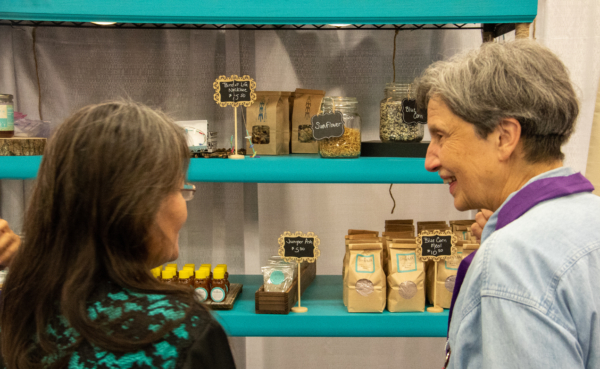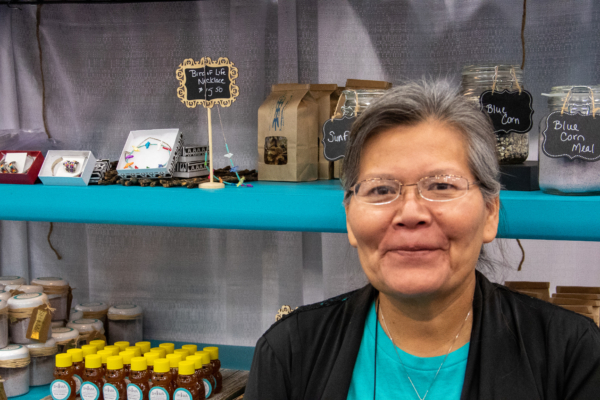Prayer books, Bibles, crucifixes – and juniper ashNavajoland entrepreneur offers traditional products for health and beauty in GC exhibit hall boothPosted Jul 9, 2018 |
|

Paula Elmore, left, assists Alice Holinger, deputy from Alaska, as she shops for Navajoland products. Photo: Mike Patterson/Episcopal News Service
[Episcopal News Service – Austin, Texas] Stroll the corridors of the sprawling Exhibit Hall at the 79th General Convention here and you’ll find nativity sets, crucifixes, prayer books, Bibles, spiritual treatises, scarves made in Jerusalem, teddy bears, promotions for trips to the Holy Land, Episcopal flip-flops (really), neckties, coffee mugs, T-shirts – and juniper ash.
Juniper ash?
“Our ancestors didn’t have cows,” explained Paula Elmore, a Navajo and Episcopalian from Fort Defiance, Arizona. “They told us to burn ash, sift it and mix it with blue corn meal to make mush or cornbread. That’s where we got our calcium.”
(Juniper is a coniferous tree with leaves like needles and tiny cones like berries. One teaspoon of ash from juniper leaves equals the calcium found in one glass of milk.)
Elmore is affiliated with Shima’ of Navajoland, a social enterprise of the Episcopal Church of Navajoland. “Our honey makes you buzz with joy” promises a sign welcoming visitors to the Shima’ booth in the Exhibit Hall.
The honey is organic, Elmore said, and comes “right from the hives.” Sometimes it also comes with a bee, but that’s picked out before it ends up in a honey jar.
If juniper ash isn’t your cup of tea, Shima’ also offers varieties of soap, including a prickly pear variety, sunflower seeds, and pinion cones, complete with sap. “Put them in your fireplace and it will smell like a pine tree,” Elmore said.
Speaking of tea, if a bishop or deputy suffers from a headache or upset tummy, they can try Navajo tea. “Our ancestors used it like aspirin or for a stomachache,” Elmore explained. It’s made from a plant (Thelesperma) that grows wild in Navajoland and “tastes a little earthy. We use the entire plant, from the root to the flower.”
[perfectpullquote align=”right” bordertop=”false” cite=”” link=”” color=”” class=”” size=””]Full ENS coverage of the 79th meeting of General Convention is available here.[/perfectpullquote]
Shima’ of Navajoland is part of the Good Shepherd Mission and Episcopal Church in Navajoland, a region that stretches over 27,000 square miles in the Four Corners region of the American Southwest.
Based at Fort Defiance, Good Shepherd was originally started as a medical mission to the Navajos in the 1880s. Today, it encompasses 50 acres, a large organic/permaculture garden incorporating Navajo techniques and a dozen buildings that serve as a retreat center and destination for mission trips.
The mission also includes two far-flung outlying parishes in Coalmine, New Mexico, and Many Farms, Arizona. Although the Navajo Reservation has a population of more than 350,000, only about 1,000 are Episcopalians.
“We are Navajo farmers, soap makers, herb gatherers, medicine men and women,” according to the Shima’ website. “We take the best of our ancient traditions and create hozho’ (beauty and harmony) through our farm and wild-gathered products.”
Elmore has done a bit of everything herself. “Beekeeper, soap maker, I’ve planted herbs and ground the blue corn,” she said.
Earth-based products aren’t the only items Elmore features from Navajoland.
Navajo women gather to craft colorful handmade stoles. Elmore says she’s done a brisk business selling them to clergy. She also has handmade silver crucifixes, an earring and bracelet set adorned with beads, and delicate necklaces decorated with tiny hummingbirds.
Shima’ says it adheres to the principles of social justice and environmental sustainability: “The way we farm, gather, create and live is to protect the precious: to protect our children, our water, our land and our sacred way of life.”
Patricia Worthington of Cave Creek, Arizona, has been visiting Navajoland on mission trips for 11 years but about nine months ago started mentoring Shima’ to help develop its business.
Worthington urges churches to consider purchasing Shima’ products to sell in their gift shops, holiday bazaars or church coffee shops. “It’s a win, win, win situation,” she explained. “You get a good product, you’re helping support Navajoland and your profits can help fund your own outreach programs,” she said.
Don’t know what to order for your church? Contact Shima’ and “we’ll walk them through the ordering process,” she said. “We don’t want churches to over-order.”
The word shima’ conveys the concept that it “is our mother, the earth created in beauty,” or hozho’, and “infuses all of life with blessing.”
– Mike Patterson is a San Antonio-based freelance writer and correspondent for the Episcopal News Service. He is a member of ENS General Convention reporting team and can be reached at rmp231@gmail.com.


Social Menu